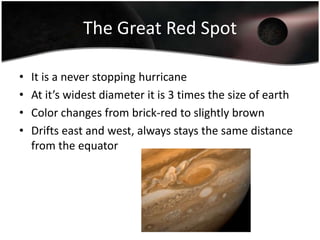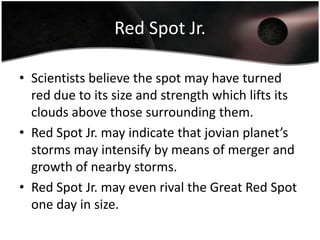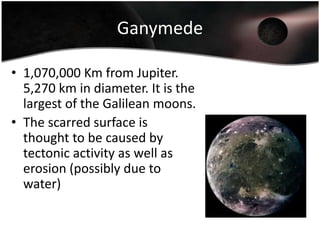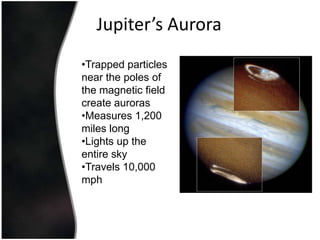Jupiter
- 2. SizeJupiter is the largest planet in our galaxy, The Milky Way.Named for the most power of the Roman gods.Jupiter’s mass is more than double that of all other planets in our solar system combined.More than one thousand Earth’s inside the volume of Jupiter.
- 3. BrightnessThird brightest object in our night sky.Only the Moon and Venus are brighter.
- 4. PhysicalFeaturesThe largest of four gas giants, the other three are Saturn, Uranus, and Neptune.Composed primarily gas and liquid, and not of solid matter. These gas giants encompass over ninety-nine percent of our solar system’s planetary mass.
- 5. Orbit and RotationThe planet orbits around the sun in a slightly elliptical pattern.It completes one orbit in 4,333 Earth days or about twelve Earth years.Jupiter rotates than any other planet in our solar systems.It rotates on its axis once every 9 hours and 56 minutes.
- 6. Mass and Density318 times larger than earthHeavier than any other planetDensity is relatively low being composed mostly of 14% Helium and 86% Hydrogen
- 7. The CoreMade of heavier elements similar to those of earth but 20 to 30 times more massiveThe core endures massive pressure making it twice as dense as Earth’s core and large enough for earth to fit inside of it with room to spare
- 8. The Great Red Spot
- 9. The Great Red SpotIt is a never stopping hurricaneAt it’s widest diameter it is 3 times the size of earthColor changes from brick-red to slightly brownDrifts east and west, always stays the same distance from the equator
- 10. MeteorologyBetween 1997 and 2000 scientists saw 3 white ovals merge in Jupiter’s southern hemisphere to form one large stormIn 2006 this storm turned from white to brown to red
- 11. Red Spot Jr.
- 12. Red Spot Jr.Scientists believe the spot may have turned red due to its size and strength which lifts its clouds above those surrounding them.Red Spot Jr. may indicate that jovian planet’s storms may intensify by means of merger and growth of nearby storms.Red Spot Jr. may even rival the Great Red Spot one day in size.
- 13. TemperatureAt the top of the clouds it’s about -230 degrees FThe temperature increases as you descend Reaching 70 degrees F with pressures 10 times as great as earth where scientists speculate life may exist.At the Center it is 43,000 degrees F which is hotter than the surface of the sun
- 14. The Layers
- 15. TemperatureIt was originally thought that Jupiter radiated the same amount of heat as it received from the Sun based on Jupiter’s surface temperatureBut based on the Galileo and Voyager missions we later found out that the surface was a little bit hotter than we thought making it radiate two times as much heat as it receives.
- 16. Jupiter: A Star?Jupiter is the only planet in our solar system that has its own internal energy source.Due to this Jupiter’s temperature drops about a millionth of a Kelvin a year.It, however, is far too cold to have ever become a star.
- 17. The Moons of Jupiter
- 18. Galileo GalileiDiscovered what we today call the Galilean Satellites almost 400 years ago.Made diagrams (below) that helped in proving the Copernican Model.
- 19. The Moons of JupiterVoyager I and II – Late 70’s/Early 80’s
- 20. Galileo probe – Late 90’s
- 21. The four moons are named Io, Europa, Ganymede and Callisto.
- 22. They are easily visible with a small telescope or binoculars.Io422,000 Km from Jupiter. 3,640 km in diameter.Densest of the Galilean Satellites.The most geologically active object in our Solar System. The most prominent surface feature are active volcanoes.The atmosphere is thin and made up of sulfer dioxide. Result of volcanoes.Volcanoes have a major effect on Jupiter’s Magnetosphere. The interior consists of iron/iron sulfide core and a rocky mantle.
- 23. Io Plasma TorusIo’s volcanic activity plays a major factor in Jupiter’s magnetosphere. The Io Plasma Torus is a region of heavy ions that follow the orbit of Io.
- 24. Europa671,000 Km from Jupiter. 3,130 km in diameter.The surface consists of an icy crust with oceans of liquid water underneath.
- 25. EuropaCracks in the surface may be caused by the tidal influence of Jupiter and/or some kind of tectonic activity.There are also the icy equivalent of lava flows where water spewed through the surface.The interior consists of iron/iron sulfide core and a rocky mantle.
- 26. Ganymede1,070,000 Km from Jupiter. 5,270 km in diameter. It is the largest of the Galilean moons.The scarred surface is thought to be caused by tectonic activity as well as erosion (possibly due to water)
- 27. GanymedeIt has been suggested that water could be present under the icy crust.The interior consists of iron/iron sulfide core, a rocky mantle and an icy crust.
- 28. CallistoAppearance is very similar to Ganymede with the exception of more craters and fewer fault lines.
- 29. CallistoNo obvious signs of geological activityThe interior consists of an ice/rock core and mantle.
- 30. OtherMoonsThere are 16 major moons (including the 4 Galilean moons)4 of the 16 major moons have retrograde orbits.Since 1997, there have been 47 discovered by systematic surveys on Earth.Around 60 total moons
- 31. Possibility of LifeDue to the presence of oceans of water under its crust, it is thought that Europa could possibly develop life.Only Earth has water on or near its surface.Environment on Europa is hostile compared to Earth.
- 32. Magnetic Field Jupiter’s magnetic field is about 14 times as strong as Earth’s.
- 33. Strongest magnetic field, except for fields associated with sun spots and other small regions of on the sun’s surface.
- 34. Its magnetic field traps electrons, protons and other electrically charged particles in radiation belt around the planet.MagnetosphereJupiter’s magnetosphere is the largest object our the universe.
- 35. Magneto tail is 435 million miles long
- 36. Jupiter’s magnetic field acts like a shield.
- 37. Protects the planet from the solar wind
- 38. The field traps the charged particles in the radiation beltJupiter’s AuroraTrapped particles near the poles of the magnetic field create auroras
- 39. Measures 1,200 miles long
- 40. Lights up the entire sky
- 41. Travels 10,000 mphJupiter speaksRadio waves given off by Jupiter reach radio telescopes on Earth in two forms- burst of radio energy and continuous radiation.
- 42. Strong burst occur when Io, passes through certain regions in the planet’s magnetic field.
- 43. Continuous radiation comes from Jupiter’s surface as well as from high energy particles in the radiation belts.RingsJupiter three rings around its equator was discovered in 1979.
- 44. Rings are more fainter than Saturn's
- 45. Consist of mostly cloud and dust
- 46. Main ring 20 miles thick and 4,000 miles wideMissions to Jupiter
- 47. Pioneer 10Launched on March 2, 1972First spacecraft to pass through the Asteroid Belt and into the outer solar system. December 3, 1973, flew by Jupiter and discovered extraordinarily high radiation levels.
- 48. Pioneer 11Launched April 5, 1973 Flew by Jupiter December 2, 1974Studied Jupiter’s magnetic field and atmosphere and photographed the planet and some of its moons. After flying by Saturn on September 1, 1979, the spacecraft continued out of the solar system. Instruments were shut down in the fall of 1995.
- 49. Voyager 1Voyager 1 launched September 5, 1977, 16 days after Voyager 2. Voyager 1 was on the fast track to fifth planet and arrived four months before Voyager 2. March 5, 1979, Voyager 1 takes more than 18,000 images of Jupiter and its moons.
- 50. Voyager 2Launched16 days before Voyager 1 on August 20, 1977Arrived four months after Voyager 1. Voyager 2 flew by Jupiter on July 9, 1979, again taking more than 18,000 images of the planet and its moons.
- 51. Voyager SpacecraftDiscoveriesBetween the two spacecraft, three new moons were discovered as well as a thin, dark ring around Jupiter. Voyager images of Jupiter's moon Io revealed active volcanoes, the first ever discovered on another body besides Earth.
- 52. GalileoLaunch: October 18, 1989Jupiter probe descent: December 7, 1995Jupiter orbit insertion: December 8, 1995Plunge into Jupiter: September 22, 2003
- 53. GalileoGalileo was also the first spacecraft to dwell in a giant planet's magnetosphere long enough to identify its global structure and investigate the dynamics of Jupiter's magnetic field. It revealed that Jupiter's ring system is formed by dust kicked up as interplanetary meteoroids smash into the planet's four small inner moons and that the planet's outermost ring is actually two rings, one embedded within the other.
- 54. UlyssesLaunched October 6, 1990 to study the north and south pole of the Sun. On February 8, 1992, the spacecraft flew by Jupiter and studied the planet’s strong magnetic field and radiation levels.
- 55. Cassini-HuygensLaunched October 15, 1997Jupiter flyby: December 30, 2000 Engineers used the Jupiter encounter to test the spacecraft's instruments and operations. During the flyby, Cassini captured incredible images of the gas giant and its larger moons in a science plan that was coordinated with Galileo observations.
- 56. New HorizonsLaunch: January 19, 2006Jupiter flyby: January-May, 2007It was the first spacecraft to observe the newly formed Little Red Spot.Photographed Io's north polar volcano Tvashtar in the middle of an eruption.
- 57. JunoPlanned for August 2011Will investigate the existence of an ice-rock core; determine the amount of global water and ammonia present in the atmosphere; study convection and deep wind profiles in the atmosphere; investigate the origin of the jovian magnetic field; and explore the polar magnetosphere.
- 58. Thank youCorey BensonApril HerreraMatthew HillburnRhonda Tipton















































